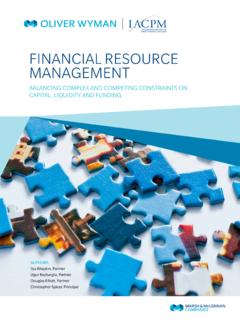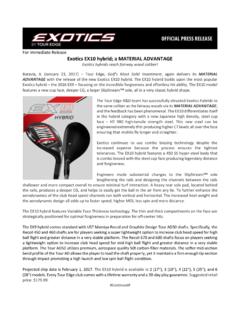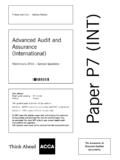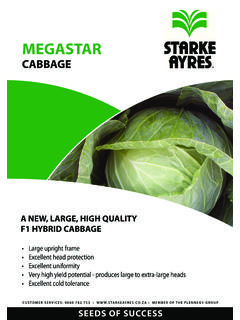Transcription of Hybrid Annuities - A Growth Story - Oliver Wyman
1 AUTHORSG uillaume Briere-Giroux FSA, MAAA, CFADean Kerr FSA, MAAA, ACIAA aron ChiongHYBRID ANNUITIESA Growth STORYC onsulting ActuariesMore and more insurers are designing and offering Hybrid Annuities (also referred to as: structured Annuities , structured-note Annuities , structured variable Annuities , structured indexed Annuities , indexed variable Annuities , and variable annuity/fixed indexed annuity hybrids). These products provide consumers with higher index-linked upside potential relative to traditional fixed indexed Annuities (FIA) in exchange for sharing some downside return risk. As shown in Exhibit 1, this innovation was first introduced in late 2010. By the end of 2013, the current market leader had garnered more than $3 BN in cumulative sales. Other entrants are starting to gain significant traction. For instance, in the fourth quarter of 2013, a second carrier reported sales between $200 MM and $300 MM, while another reported $90 1: Hybrid annuity launches and filings (as of mid-2014)October 2010 AXA Equitable introducesStructured Capital StrategiesMay 2013 MetLife introducesShield Level SelectorAugust 2013 CUNA Mutual introducesMEMBERS Zone AnnuitySeptember 2013 Allianz Life introducesIndex AdvantageMay 2014 Voya Financial filesPotentialPlus with the SEC*20102011201220132014*Since the publication of this article, the Voya PotentialPlus product has been this article we aim to address the following questions: What is the consumer appeal of Hybrid Annuities ?
2 What are key design and pricing considerations? What is the future outlook for these products?Copyright 2015 Oliver Wyman 1 WHAT IS THE CONSUMER APPEAL?Generally speaking, Hybrid Annuities fill the risk spectrum between FIAs and accumulation variable Annuities (VAs) invested in an indexed fund. Hybrid annuity crediting structures include buffer designs and floor designs. The consumer risk profile of FIA with annual cap, VA and these two types of Hybrid designs is displayed in Exhibit 2: Index-linked account value Growth profile (before fees)FIXED INDEXED ANNUITYVARIABLE ANNUITYHYBRID ANNUITY BUFFER DESIGN Hybrid ANNUITY FLOOR DESIGN Account value growthIndex returnAccount value growthIndex returnAccount value growthIndex returnAccount value growthIndex returnAs shown in Exhibit 2, Hybrid contracts can produce negative returns if index performance is negative.
3 For buffer designs, this will be the case when the drop in the index exceeds the buffer. Once the buffer is breached, losses are uncapped. On floor designs, negative returns immediately lead to losses, but losses are limited to the unlike FIAs and VAs, Hybrid Annuities typically offer a choice of investment options. Policyholders may generally allocate funds to desired indices, crediting methods, crediting terms and protection levels. Unlike VAs, assets are not invested directly in unitized funds held in the separate account; rather, Hybrid annuity policyholders participate indirectly in the performance of the underlying index, and assets supporting the contract are held in a non-unitized separate ARE KEY DESIGN AND PRICING CONSIDERATIONS? Hybrid Annuities are currently registered with a prospectus filed with the Securities and Exchange Commission (SEC). Prospectus language differs by design with respect to whether the contracts represent a variable and index-linked deferred annuity , deferred variable annuity or deferred annuity.
4 Some common characteristics of currently available products are: Lack guaranteed living benefits Link to an index (typically an equity index) Preserve the tax deferral, death benefits, and withdrawal provisions of traditional annuitiesHybrid Annuities can be broadly categorized as FIA like and VA like designs, with the characteristics described in Exhibit 3: Overview of Hybrid annuity designs FIA LIKE DESIGN VA LIKE DESIGN No M&E fee Policyholders can allocate to one or more segments/accounts Each segment/account credits a return based on the underlying index, term, buffer or floor M&E fee Policyholders can allocate between variable options and structured investment/index options Variable options behave like a traditional VA Structured investment/index options behave similarly to FIA like products Investment expense (applies to variable options only)When designing and pricing a Hybrid annuity, actuaries need to consider a range of pricing, risk management and regulatory matters: Policyholder behavior: Although the lack of guaranteed living benefits simplifies the pricing, Hybrid annuity design brings additional considerations related to interest-sensitive and index-sensitive dynamic lapses.
5 Impact of hedging: How can the synergies with existing FIA and VA designs be leveraged to reduce costs or increase competitiveness? Complexity: Certain Hybrid annuity designs offer a wide range of crediting methodologies with varying terms. How will this complexity impact the modeling, administration, management of non-guaranteed elements, and general risk management of the business? Reserving: Hybrid Annuities do not have well-established US Statutory or US GAAP accounting frameworks; modeling and implementation of reserving methodologies can be complex. Regulatory concerns: Regulatory concerns surrounding Hybrid Annuities are generally related to the filing of these products as VA contracts and possible conflicts with both the Variable Annuity Model Regulation and the Standard Nonforfeiture Law for Individual Deferred 2015 Oliver Wyman 2 WHAT IS THE OUTLOOK FOR Hybrid Annuities ?
6 Although banks have offered structured notes for some time, Hybrid Annuities are relatively new and sales continue to gain momentum, presenting opportunities for new entrants. We believe that the following factors will contribute to existing carriers expanding their offerings and new carriers entering this market: Consumer appeal: Hybrid Annuities help fill the risk spectrum between FIAs and VAs and offer considerable flexibility to consumers. Access to new distribution: Existing FIA carriers, in particular, may use Hybrid Annuities to expand sales with registered advisors and gain traction in new channels. Balancing product profile: Many VA carriers have significantly reduced their appetite for living benefit guarantees or have reached maximum capacity. Hybrid Annuities offer existing VA carriers a new opportunity to attract assets without offering living benefits. Offsetting VA guarantee risks: Hybrid Annuities can be designed in such a way as to help insurers offset risks from existing VA books and provide capital benefits.
7 Sustainable design in a low rate environment: Hybrid Annuities are less exposed to interest rate risk than FIAs or VAs with living benefit OF KEY VA, FIA AND Hybrid ANNUITY DESIGN ELEMENTSFIXED INDEXED ANNUITY No downside risk1 Participate indirectly in the performance of the underlying index Choice of index, crediting method and term Guaranteed minimum crediting rate Fixed account is available Guaranteed non-forfeiture valueVARIABLE ANNUITY Unlimited downside risk Invest directly in separate accounts/funds Fixed account is often, but not always available No guaranteed minimum crediting rate outside of the fixed accountHYBRID ANNUITY Downside risk with some protection via buffer or floor Participate indirectly in the performance of the underlying index Choice of index, crediting method, term and protection level No guaranteed minimum crediting rate Fixed account is not usually available (only one carrier offers a fixed account in the investment options)1 Ignores surrender charges and other account-based 2015 Oliver Wyman 3 REFERENCESB riere-Giroux, G.
8 (2014, May). Fixed Indexed Annuity Recap and What s Next. Retrieved June 20, 2014, from Oliver , L. (2013, September 25). A Look Behind The New Structured Annuities . Retrieved May 9, 2014, from Annuity , L. (2014, March 19). A Registered Index Annuity Takes Off. Retrieved May 9, 2014, from Annuity , D. (2014, February 23). The latest annuity innovation: Contracts with structured products. Retrieved May 9, 2014, from Investment Account Index Linked Variable Annuity Subgroup. Discussion Points for Separate Account Index-Linked Products. (2014, January 15). Retrieved June 2, 2014, from National Association of Insurance 2015 Oliver Wyman 4 Copyright 2015 Oliver WymanAll rights reserved.
9 This report may not be reproduced or redistributed, in whole or in part, without the written permission of Oliver Wyman and Oliver Wyman accepts no liability whatsoever for the actions of third parties in this information and opinions in this report were prepared by Oliver Wyman . This report is not investment advice and should not be relied on for such advice or as a substitute for consultation with professional accountants, tax, legal or financial advisors. Oliver Wyman has made every effort to use reliable, up-to-date and comprehensive information and analysis, but all information is provided without warranty of any kind, express or implied. Oliver Wyman disclaims any responsibility to update the information or conclusions in this report. Oliver Wyman accepts no liability for any loss arising from any action taken or refrained from as a result of information contained in this report or any reports or sources of information referred to herein, or for any consequential, special or similar damages even if advised of the possibility of such damages.
10 The report is not an offer to buy or sell securities or a solicitation of an offer to buy or sell securities. This report may not be sold without the written consent of Oliver Oliver WYMANO liver Wyman is a global leader in management consulting. With offices in 50+ cities across 25 countries, Oliver Wyman combines deep industry knowledge with specialized expertise in strategy, operations, risk management, and organization transformation. The firm s 3,000 professionals help clients optimize their business, improve their operations and risk profile, and accelerate their organizational performance to seize the most attractive opportunities. Oliver Wyman is a wholly owned subsidiary of Marsh & McLennan Companies [NYSE: MMC], a global team of professional services companies offering clients advice and solutions in the areas of risk, strategy, and human capital. With 52,000 employees worldwide and annual revenue exceeding $10 billion, Marsh & McLennan Companies is also the parent company of Marsh, a global leader in insurance broking and risk management; Guy Carpenter, a global leader in risk and reinsurance intermediary services; and Mercer, a global leader in human resource consulting and related Actuarial Practice of Oliver Wyman has life, health and property & casualty actuaries that advise financial institutions, insurance companies, regulators and self-insured entities across a broad spectrum of risk management issues.














